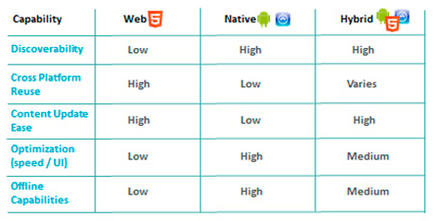Can you Pass the Enterprise Mobile Test? 3 Things to Know Before Going Mobile

By: Josh Galde, Mobile Evangelist at Keynote (www.keynote.com)
Developing a coherent enterprise mobile strategy has become critically important to any organization looking to stay relevant and harness the power of mobility. ABI Research predicts 56 billion smartphone apps will be downloaded in 2013. Likewise, a recent study from Pew Research found that two-thirds of cellphone owning Americans currently use their phones to surf the Web and check e-mail, double the amount reported in Pew's 2009 survey, when only 31 percent said they used their phones to go online. More and more these days people are using their mobile devices to buy goods from online retailers, check their bank balances or deposit checks, and in the workplace to increase their productivity through specially designed efficiency and collaboration apps. Gone are the days when enterprise mobility was a novelty or a mere trend. The mobile channel is here to stay and user expectations now reflect this overall mobile maturation.
So whether you're planning to build a new productivity app for your employees or deciding whether to go Native, Web-based or Hybrid with a consumer-facing mobile presence, all businesses need to be mindful that the stakes have been raised when it comes to the enterprise mobile user experience.
Here are three things you need to know to help ensure that you pass the mobile test and provide your target market with a flawless mobile user experience that will keep them coming back for more.
1. All devices are not created equal
Device fragmentation has always presented challenges for the mobile developer, but new complexities continue to be introduced with the increased diversity and sophistication of today's mobile devices. Although there has been a reduction of predominant mobile operating systems, the number of device types and screen resolutions for Android and iOS has exploded. Since Android is an open platform for developers it introduces inherent differences in the functionality and performance of each device.
For iOS, while there is less platform fragmentation, the introduction of the iPhone 5 presented a new difference in form factor (screen size) from its previous models, adding to the complexities of fragmentation. And while many iPhone users will automatically upgrade to each successive iOS update, there will still be many users on older OS versions, further fragmenting the iOS market.
With Google's recent announcements around "mobile first", many mobile website developers are turning to responsive design to create a single, unified experience across desktop and mobile devices to optimize resources.
Device diversity is important to factor in when going mobile. Whether you are developing a mobile version of your flagship website, a utility for the enterprise or a standalone mobile app, understanding fragmentation in the mobile market is critical. Not addressing this issue at the beginning of the development process can mean the difference between a successful mobile launch and a failing grade based on a poor initial user experience.
2. Native, hybrid or Web...oh my!
Another important thing to consider when devising a go-to-market mobile plan is which development strategy makes the most sense for you. Should you build a mobile website, a native application, or a combination of the two - what's known as a hybrid?
The choice between developing a mobile website or a native application can be a difficult one. While creating a mobile website can be less costly to develop and easy to change/update, a native application generally has better performance and a branded experience for the user.
Native vs. Web continues to be an ongoing debate. However, many industry leaders are starting to show favorable interest towards leveraging hybrid applications, essentially a web application within a native application wrapper. This allows the application to have the immersive look and feel of a downloaded, branded mobile app, but with the benefit of allowing quick and easy content updates from the web.
When developing for the enterprise, Gartner recommends hybrid apps and reported that more than 50 percent of mobile apps will be of the hybrid variety by 2016. With businesses under great pressure to develop and deploy applications much quicker, hybrid apps represent a solution that helps to address some of the key issues of resource allocation, saving time and money for mobile development and quality assurance.

3. Testing for quality is key to ensuring ROI for Enterprise Mobile Applications
Speaking of quality assurance, there is nothing that will cause you to flunk the mobile exam faster than failure to properly test your mobile assets across a number of platforms, devices and networks. A flashy new mobile app or website that has not been properly tested before launch, as well as tested and monitored post-launch, is worse than useless -- it's a liability that can do lasting damage to your mobile credibility and ultimately, your brand.
Performance and quality are the keys to mobile adoption. This means that to ensure ROI, you need to test your application pre-launch and also continue to test and monitor post-launch to ensure continued high performance. Mobile testing not only includes functional testing, but also usability and performance testing. Widespread adoption will not occur with an application that is slow, balky or non-intuitive.
A common mistake that developers make is not leveraging emulated or real-device testing and instead assuming that their SDK testing during development will be sufficient. Depending on your application and use case you will have to assess whether testing on an emulated device or real device is the best option for you. Most of the time you will find that it is not an either/or proposition, it is almost always both. While emulated testing is generally the less expensive option, it offers some limitations and may not give an accurate depiction of the real user experience.
With the rise of cloud-based testing options, it is no longer necessary to have a bunch of people in a room banging away on different mobile devices. Testing on real devices gives the tester access to the full functionality of the mobile device being tested. While device types may be more limited than the emulated devices, testers will be able to write scripts that include touch events, use of device peripherals, making phone calls on the network, SMS texting, HTML5 capabilities, and other features.
It is clear that the mobile channel has reached a level of maturity and market penetration where it can no longer be ignored. From online retailers, to financial service providers, to the travel & hospitality industry, all will need to have a fully-fledged mobile presence in the coming months in order to compete and be taken seriously.
If you are mindful of the three areas discussed above - Device Fragmentation, Native vs. Web, and Testing - you should pass the mobile test with flying colors and deliver a mobile presence to be proud of and one that will, in turn, provide excellent ROI.

Subscribe to Our Newsletter!
Latest in Mobile Marketing










